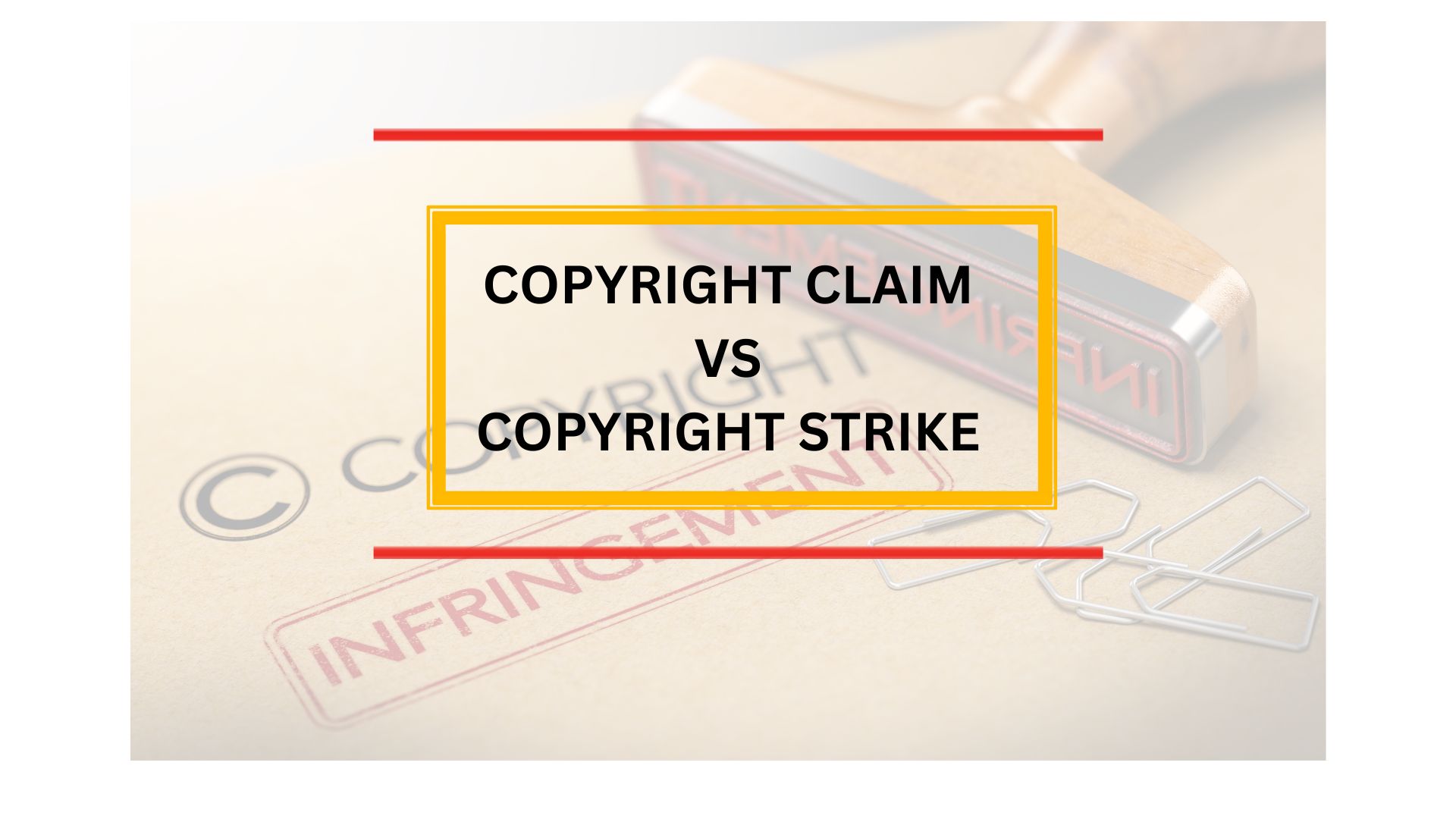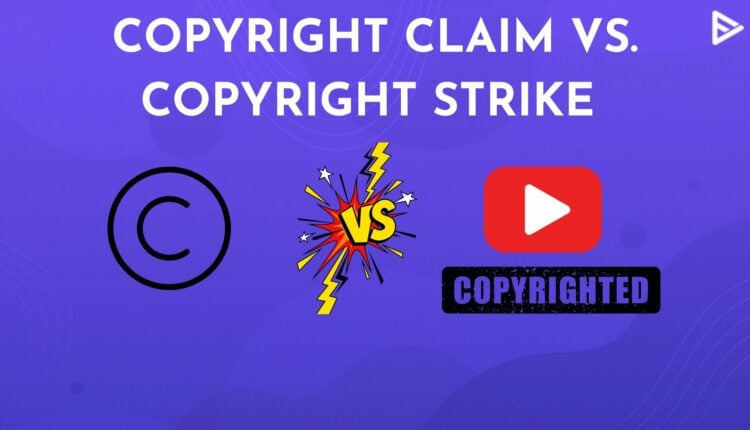A YouTuber must know the difference between a YouTube copyright claim vs. strike! In this article, we will discuss the differences between YouTube copyright claims vs strikes so that content creators can avoid infringement issues on their channels. But first, let us understand what copyright means in general.
What Does Copyright Mean?
YouTube Copyright refers to the legal right or intellectual property that allows the owner to retain the original rights to the work completed by them. Copyright includes various types of work, such as music, audio, video, art, books, and designs.
So, a copyright owner can legally claim ownership of their work, identify their work, and take desired action if their work/art has been used or published without their consent.
What Is A Copyright Claim On YouTube?
A Copyright claim on YouTube is called a Content ID Claim. YouTube has strict and stringent rules, and if a video violates the copyright claim rules without authorization.
So, when a copyright claim is sent to you by the owner, here are a few things that you must know about the Content claim ID:
- The Content ID will only affect that one particular video. It will not affect the entire YouTube channel.
- The copyright owner may include advertisements in the video to profit from them.
- The Copyright owner can demand a cut of the profits you might earn from the video.
- Claims of copyright infringement or Content ID theft can be debunked with evidence of ownership or permission to use the claimed content. You can ask for a retraction or submit a counter-notification.
How YouTube Issues Copyright Claims?
When a piece of content, a video, a music clip, or any media is not owned by the YouTube creator for publication, YouTube issues a copyright claim. YouTube handles copyright claims through its Content ID system and manual reporting tools. Content ID allows copyright owners to upload reference files, which YouTube scans against uploaded videos to detect matches.
So, if any copyrighted content is uploaded on a YT channel, the owner can block the video, mute it, or include monetization. This means that a part of the revenue will be returned to the owner as compensation.
What Can Happen if a Copyright Claim is Made on Your Video?
When a copyright claim is placed on your video, it can limit its visibility and prevent you from monetizing it. The rights and responsibility for the video are transferred to the claim holder, allowing them to collect a portion or even all of the revenue generated. As a result, you may earn no revenue from the video while the claim holder benefits instead.
In addition to restricting views, the claim holder may choose to monitor the video or entirely disable monetization based on its performance.
What Is Copyright Strike?
Let us discuss what is a YouTube Copyright strike now.
When the owner of the copied work objects firmly to the video’s use of his work, the video is “struck” for copyright infringement and is pulled down from YouTube. This occurs when the rightful owner files a request for removal under the DMCA (Digital Millenium Copyright Act).
If the YouTuber does not respond with a notice within 10 business days, YouTube will remove the violating video. However, the uploader of the copyrighted infringement video will have to face the consequences, unlike with a Content ID claim, where it does not affect the entire channel.
Following the first copyright strike, channel features, such as YT monetization and live streaming, will be affected for 7 days. The effects of the first strike will remain for 90 days, and the disadvantage will expire after 3 months.
If your channel receives a second and a third copyright strike within the expiration of the first strike, the account can be terminated, and you will not be allowed to create a new one.
As a courtesy, after three copyright strikes, you will be allowed an additional seven days to participate in the YPP, and you can act during that buffer time before the channel is disabled.
How YouTube Issues Copyright Strikes?
A copyright strike on YouTube occurs when copyright owners file a formal takedown request for a video that uses their content without permission. Unlike copyright claims, strikes are more serious and can impact a creator’s channel. When a strike is issued, YouTube removes the video, and the creator receives a notification in YouTube Studio explaining the reason.
In such cases, the rights holder has to provide specific detailed information for the takedown request:
- Contact information of the owner
- Proof and description of the material(video clip, music, image, or a gif) being used without permission.
- A statement of good faith that the material is being used without permission.
What Happens When You Receive a Copyright Strike?
The following are the consequences of receiving a copyright strike against a creator’s channel:
- First Strike: Acts as a warning with restrictions but can be resolved.
- Second Strike: Stricter restrictions are applied, lasting up to 90 days.
- Third Strike: Your channel and all content may be permanently removed or terminated from YouTube.
Copyright Claim Vs. Strike: Major Differences
Coming to the key differences between copyright claims vs. strikes, let us take a closer look at the differences. Remember these tips, especially when you promote music video on YouTube.

- Process: In the Copyright claim, a YouTube automated system generates the Content ID claim. On the other hand, the content creator must manually register a copyright strike.
- Penalty: The severity of a copyright claim vs. strike also differs. A copyright strike can have lasting effects on a YouTuber’s reputation and ability to participate in the platform, and a copyright claim might result in the deletion of content or the copyright owner monetizing it.
- Time: Often, a content ID claim will not result in a copyright strike, and the accused will be given time to respond to clarify and rectify the claim. However, a copyright strike can lead to financial loss, as the channel’s performance can be affected. YouTube can terminate the channel or take legal action against the content creator if there are 3 strikes against the channel.
Conclusion
These are the crucial differences between copyright claim and copyright strike because both terms are often misunderstood and considered the same by content creators. As a content creator, always use original content or obtain legal permission to use copyrighted material to avoid any copyright strikes in the future.
Audience growth can be a key priority as you scale your YouTube channel. VeeFly is a highly trusted and widely used YouTube promotion service provider that helps creators grow their YT channel by reaching the right audience. Whether you want more YouTube likes on your videos or want to increase your YouTube channel subscribers, we have your back at every step of your YT journey.
Frequently Asked Questions
Q1. How Many Copyright Claims Equals A Strike?
Repeat offenders can end up with a copyright strike by YouTube. Generally, 50 copyright claims can result in one copyright strike.
Q2. Is It OK To Have Copyright Claim?
Copyright claims do not lead to legal penalties or channel termination. This simply means that the copyright owner may request that the violating segment of the video be removed, muted, or monetized.
Q3. How Can I Remove Copyright Claim?
You can edit your video’s copyrighted portion if you receive a copyright claim. If you have enough proof, you can submit a copyright counter-notification, and YouTube can retract the claim if you believe there has been a mistake made by the other content creator.
Q4. Do Copyright Claims Expire on YouTube?
Yes. YouTube has introduced a method to resolve copyright strikes, allowing creators to wait 90 days for the claim to expire.
Q5. Does getting a copyright claim affect views?
Yes, a copyright claim can affect views. It can affect in the following ways:
- The video can be blocked.
- The video can be restricted.
- The video can be available, but the copyrighted sections can be mute.d
- The owner can monetize the video
Q6. Is Content ID claim the same as copyright strike?
Content ID claims and copyright strikes are different than each other. Content ID can block the video from being viewed and usually does not impact the channel if the claimant responds within 30 days of the dispute. Copyright strikes can seriously impact the channel, including account suspension and legal actions if your channel receives more than 2 copyright strikes.


